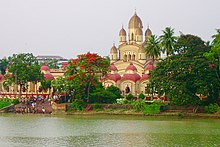West Bengal is the fourth most populous state in India with a population of 91,347,736 (7.55% of India's population; census 2011 fig.)Majority of the population comprises Bengalis. The Bihari minority is scattered throughout the state and communities of Sherpas and ethnic Tibetans can be found in regions bordering Sikkim. Darjeeling district has a large number of Gurkha people of Nepalese origin. West Bengal is home to indigenous tribal Adivasis such as Santals, Kol, Koch-Rajbongshi and Toto tribe.
The official language is Bengali and English. Hindi is also commonly used. Nepali is spoken primarily in the Darjeeling district. Languages such as Rajbongshi, Santali and Ho are used in some parts of the state. Urdu is used primarily in Central Kolkata. There were also many Armenians, Greeks and Jews, although these have declined in 20th century. After the establishment of Israel, many Jews left to live in Israel and the size of the Jewish community had a severe decrease. Chinatown in the eastern part of the city of Kolkata is the only Chinatown in the country. The locality was once home to 20,000 ethnic Chinese, now the population has dropped to 2,000 or so. The traditional occupation of the Chinese community here had been working in the nearby tanning industry and the Chinese restaurants.
As of 2001, Hinduism is the principal religion at 72.5% of the total population, while Muslims comprise 25.2% of the total population , being the second-largest community as also the largest minority group; Sikhism, Christianity and other religions make up the remainder. West Bengal has a population density of 904 inhabitants per square kilometre (2,340 /sq mi) making it the most densely populated state in India. The state contributes 7.8% of India's population. The state's 1991–2001 growth rate of 17.8% is lower than the national rate of 21.3%. The gender ratio is 934 females per 1000 males.
The literacy rate is 77.1%. Data of 1995–1999 showed the life expectancy in the state was 63.4 years, higher than the national value of 61.7 years. About 72% of people live in rural areas. The proportion of people living below the poverty line in 1999–2000 was 31.9%.Scheduled Castes and Tribes form 28.6% and 5.8% of the population respectively in rural areas, and 19.9% and 1.5% respectively in urban areas.
The crime rate in the state in 2004 was 82.6 per 100,000, which was half of the national average. This is the fourth-lowest crime rate among the 32 states and union territories of India. However, the state reported the highest rate of Special and Local Laws (SLL) crimes. In reported crimes against women, the state showed a crime rate of 7.1 compared to the national rate of 14.1. Some estimates state that there are more than 60,000 brothel-based women and girls in prostitution in Kolkata. The population of prostitutes in Sonagachi constitutes mainly of Nepalese, Indians and Bangladeshis.Some sources estimate there are 60,000 women in the brothels of Kolkata. The largest prostitution area in city is Sonagachi. West Bengal was the first Indian state to constitute a Human Rights Commission of its own.



No comments:
Post a Comment